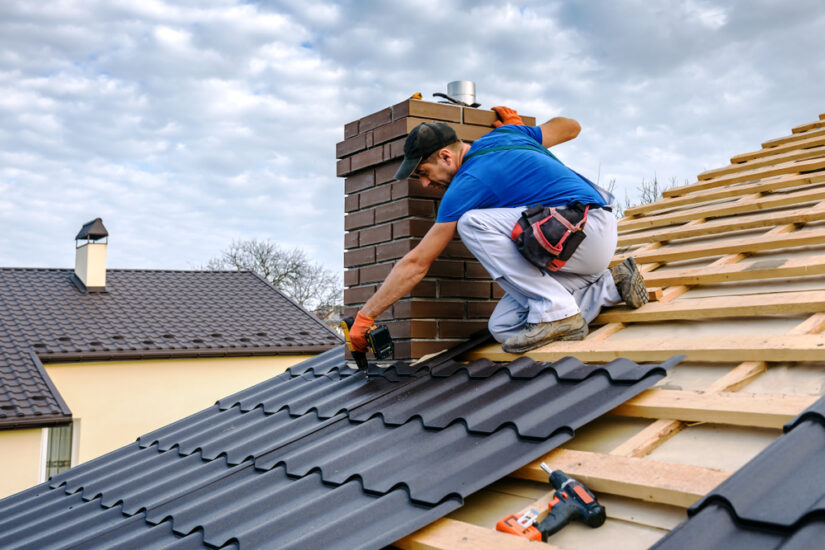Why Is My Chimney or Step Flashing Leaking, and How Is It Fixed?
If your chimney or step flashing is leaking, the most common cause is damaged or improperly installed flashing. Flashing serves as a barrier to prevent water from seeping into the areas where the chimney meets the roof, so any cracks, gaps, or corrosion can allow water to enter and cause leaks.
You might also find leaks caused by deteriorated mortar, cracked chimney crowns, or missing chimney caps, but flashing damage remains the primary issue. Fixing it usually involves inspecting the flashing, cleaning the area, resealing with roofing cement, or replacing the flashing entirely if it’s beyond repair.
Addressing these issues promptly helps protect both your roof and chimney structure from water damage, rot, and costly repairs down the line. That is why you should contact a roof leak repair contractor if you notice any extensive damage to your step flashing.

What Causes Chimney and Step Flashing Leaks?
Leaks around your chimney most often stem from problems with the flashing. These issues typically involve damaged materials, improper installation, or wear over time. Knowing what flashing does, where it fails, and how leaks show up can help you identify and address the problem quickly.
Understanding Chimney Flashing and Its Purpose
Chimney flashing is the metal barrier that seals the gap between your chimney and the roof. Its main purpose is to prevent water from seeping into your home through this vulnerable joint.
Flashing is usually made from aluminum, copper, or galvanized steel. It includes step flashing, which is installed in layers around the chimney base to direct water away from the roof. Properly installed flashing is tightly sealed and integrated with roofing materials to keep moisture out.
Without effective flashing, water can enter your home, leading to damage like mold, wood rot, and rust around metal components.
Common Flashing Problems and Failure Points
The most frequent issues causing flashing leaks include rust, cracking, and separation from the roof or chimney. Exposure to weather cycles can make flashing brittle or cause it to loosen.
Step flashing may corrode or pull away from the chimney wall, especially if nails or soldering fail. Damaged or missing flashing pieces create direct pathways for water during rain.
Other problems include cracked chimney mortar or crown, which can undermine the flashing seal. Improper initial installation, such as poor sealing or uneven surfaces, also leads to leaks.
Recognizing Signs of Flashing Leaks
You might notice water stains on ceilings or walls near the chimney or inside your attic. Musty odors can develop from trapped moisture. Rusted metal flashing or nails visible on your roof are indicators of deterioration.
Pooling water around the chimney base or damp spots on the roof decking consistently after rain suggests flashing issues.
Early signs include peeling paint or wallpaper in rooms adjacent to the chimney. Catching these signs early helps you avoid extensive water damage and costly repairs.
How Are Chimney and Step Flashing Leaks Fixed?
Fixing leaks in chimney or step flashing involves careful inspection, removing damaged flashing, and installing new, properly sealed materials. The repair can be done as a DIY project or by professionals, with clear trade-offs between cost and expertise. Acting quickly to repair flashing leaks protects your roof and structure from water damage.
Professional Repair Process Explained
When professionals handle flashing repair, they start by inspecting the chimney and surrounding roof areas for damage or deterioration. At Jackson Contracting, a professional roofing company, this includes checking both step flashing and counter flashing for rust, cracks, or loose sections.
Next, they remove the old flashing carefully to avoid further damage to shingles or chimney masonry.
New flashing, typically aluminum, copper, or galvanized steel, is custom-cut and shaped to fit tightly around the chimney base. Proper installation involves layering step flashing under shingles and securing counter flashing over chimney bricks.
Finally, all joints are sealed with high-quality waterproof sealants to ensure a watertight barrier. A water test is often performed to verify the repair before the job is complete.
DIY Versus Professional Flashing Repairs
You can attempt DIY flashing repair if you have basic roofing experience and the right tools. The process requires removing shingles, replacing or patching flashing, and resealing seams. Consider DIY if you:
- Have minor flashing damage
- Can safely work on your roof
- Understand sealing techniques
However, flashing repairs involve critical waterproofing work. Mistakes can lead to ongoing leaks and costly damage. Professionals offer precision cutting, proper installation, and warranty coverage.
If you notice extensive rust, warped flashing, or structural chimney damage, hiring a pro is safer because they also have access to specialized sealants and can ensure the repair lasts longer.

Long-Term Benefits of Prompt Flashing Repair
Fixing flashing leaks promptly prevents water from seeping into your home’s roof structure and walls. This reduces the risk of mold, wood rot, and interior ceiling damage. A timely repair helps maintain your roof’s integrity, extending its lifespan and preventing the need for costly full roof replacements. With proper flashing sealants, you ensure the waterproof barrier functions for years.
Additionally, early action on leaks helps protect chimney masonry from erosion caused by moisture. It also safeguards your insulation and attic from water damage.
Addressing leaks early saves you money on repairs, reduces health risks from mold, and keeps your home comfortable and secure.
Maintaining and Protecting Your Chimney Flashing
Proper care of your chimney flashing prevents leaks and extends its lifespan. Regular inspections and timely repairs are key to avoiding water damage. Knowing when to act and which services to seek helps you maintain a secure roof.
Maintenance Tips for Homeowners
Inspect your chimney flashing at least twice a year, especially after heavy storms. Look for cracks, rust, loose nails, or gaps where water might enter. Pay close attention to areas where flashing meets roofing materials and chimney mortar.
Clean debris and seal small gaps with roofing cement or high-quality sealant to stop minor leaks quickly. Avoid using caulking or adhesives that are not designed for flashing repair, as they can fail under weather stress.
Keep nearby gutters clean to ensure proper water runoff. Trim tree branches that could damage flashing during wind events, and schedule professional inspections every few years to catch issues that are hard to see.
Related Roof Leak and Installation Services
If flashing damage is severe, replacement is often necessary. Professional roofers can install new flashing correctly, using materials like aluminum, copper, or galvanized steel suited for your climate and roof type.
Step flashing repair is crucial if gaps exist between shingles and chimney walls. Roof leak diagnosis often includes checking flashing integrity as a primary cause.
Additional services may include chimney rebuilding or mortar joint repairs to support counter flashing. Consider hiring a licensed roof installation contractor who offers guarantees and has experience with chimney flashing systems. This ensures repairs are durable and comply with building codes.
